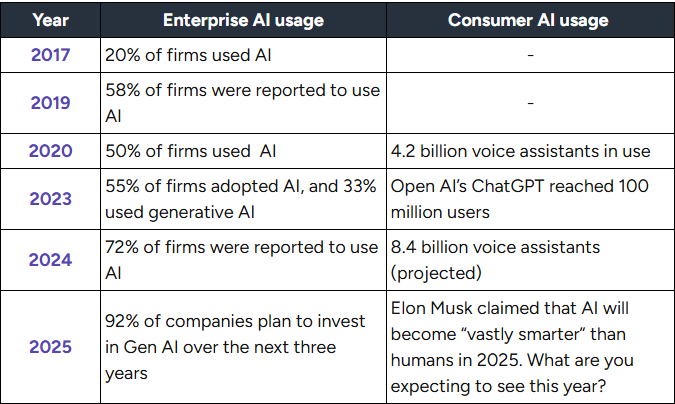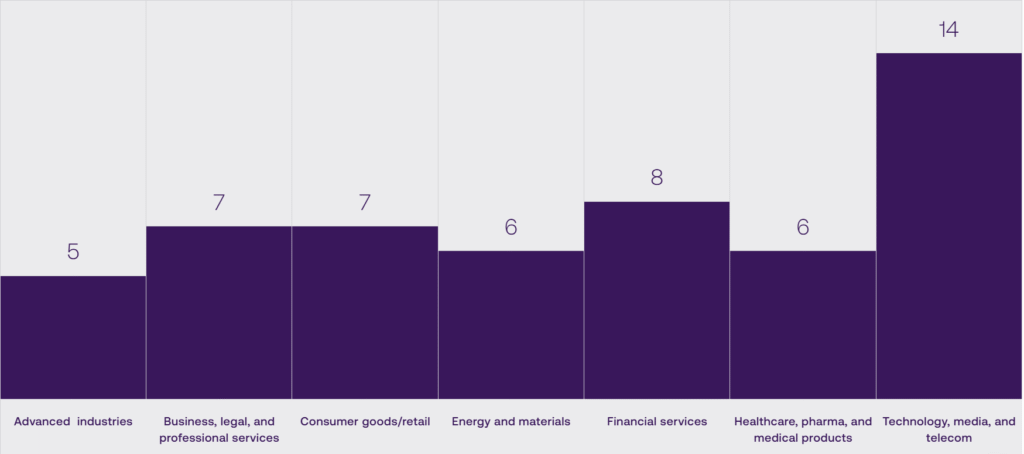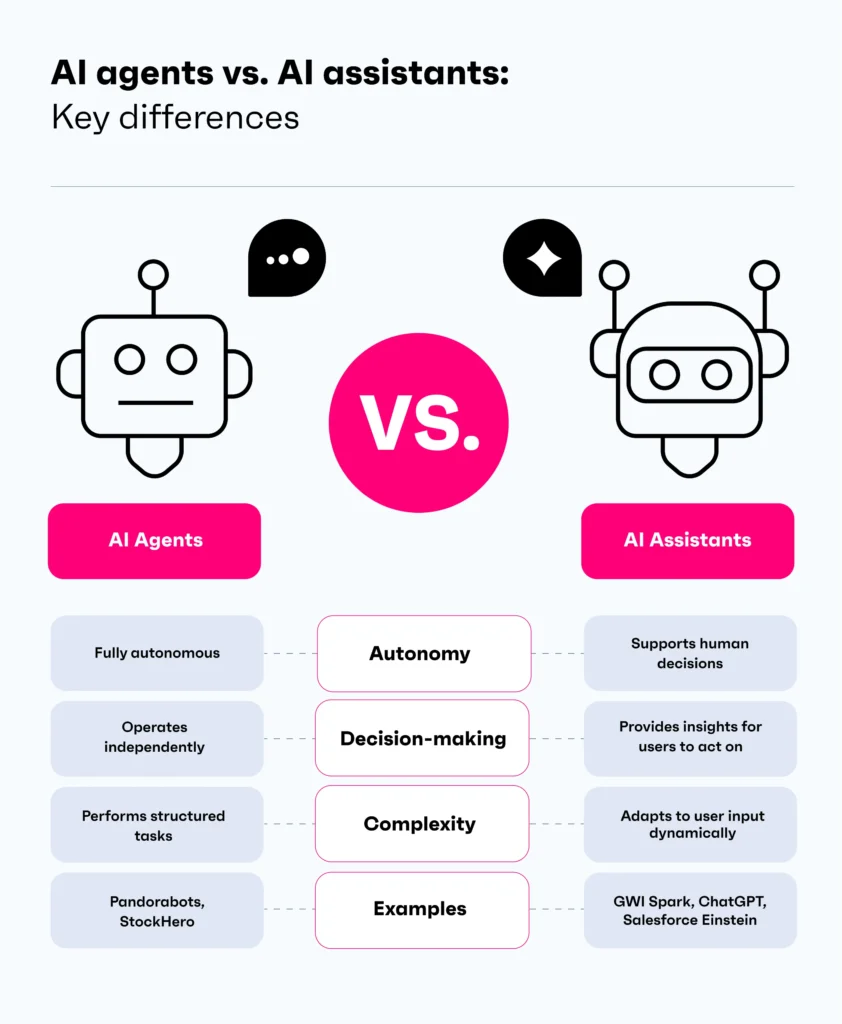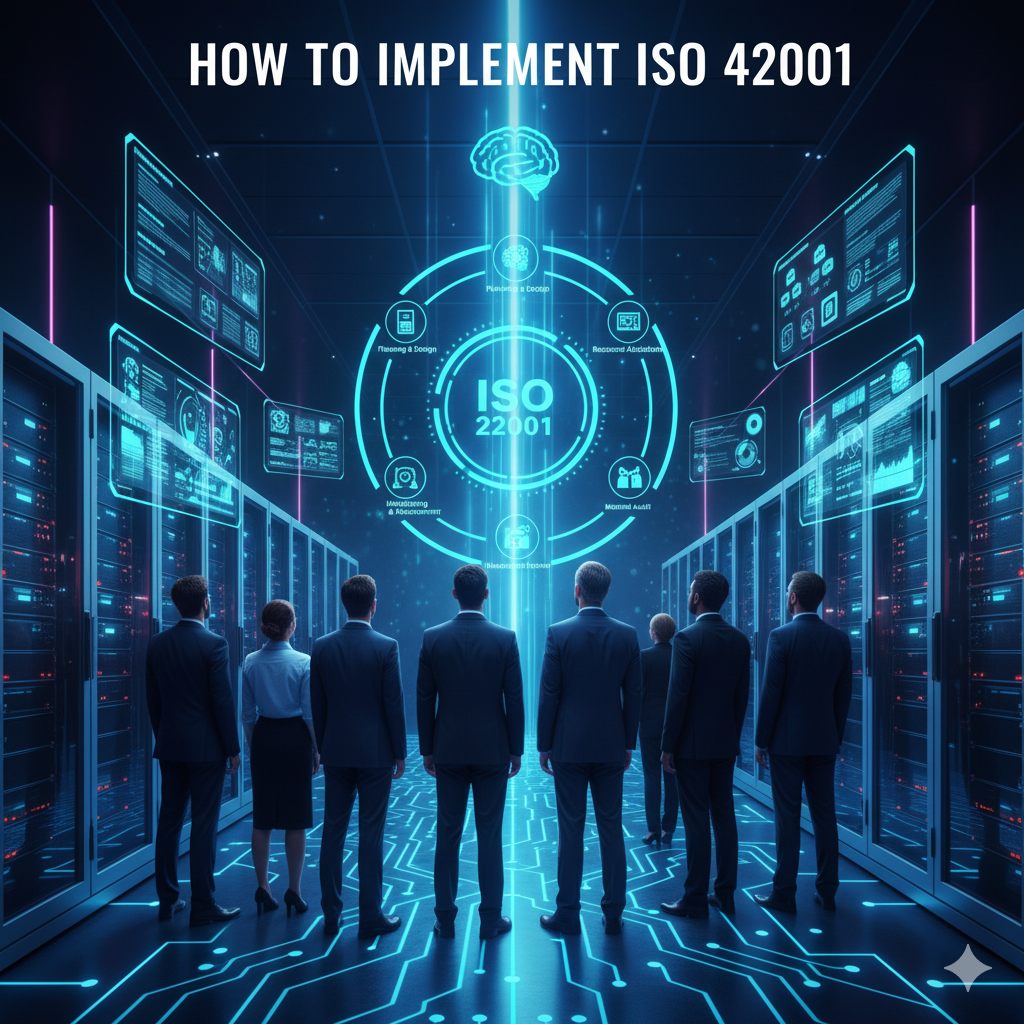The artificial intelligence landscape continues to evolve rapidly, introducing new concepts and technologies that can transform how businesses operate. Among the most significant developments are AI agents and AI assistants—two distinct types of intelligent systems that serve different purposes and operate with varying levels of autonomy. While these terms are often used interchangeably, understanding their key differences is crucial for making informed decisions about which technology best serves your organization’s needs.
The fundamental distinction lies in autonomy and function. AI assistants operate as reactive systems that respond to user prompts and perform tasks when requested, while AI agents function as autonomous systems that proactively pursue goals and make independent decisions with minimal human intervention. This difference has profound implications for how organizations integrate these technologies into their workflows, manage risk, and achieve business outcomes.

What Is an AI Agent
AI agents are autonomous software programs designed to operate independently and make decisions without continuous user input to achieve specific objectives. These sophisticated systems combine reasoning, planning, memory, and learning capabilities to navigate complex environments and adapt their strategies based on experience and changing conditions.
Key characteristics of AI agents include:
- Autonomy: Operates independently without continuous user input, making decisions and taking actions based on programmed objectives and environmental conditions.
- Goal-orientation: Designed to achieve specific objectives proactively, working persistently toward defined outcomes without requiring step-by-step human guidance.
- Reasoning and Planning: Capable of complex problem-solving and strategy formulation, breaking down complex tasks into manageable subtasks and developing multi-step execution plans.
- Memory and Learning: Learns from past experiences to improve decisions over time, maintaining both short-term context and long-term patterns to enhance future performance.
- Suitable for Complex Tasks: Effective in dynamic, multifaceted environments where rapid adaptation and continuous operation provide competitive advantages.
Example: A financial trading bot that analyzes market trends, evaluates risk parameters, and executes trades autonomously based on predefined strategies, continuously learning from market feedback to optimize performance.
AI agents excel in scenarios requiring sustained autonomous operation, such as monitoring systems, optimizing processes, and managing workflows across multiple platforms. Their ability to operate without constant human oversight makes them particularly valuable for tasks that benefit from 24/7 operation or rapid response times that exceed human capabilities.
What Is an AI Assistant
AI assistants are reactive systems that wait for user input and perform straightforward, task-based functions in response to specific commands or requests. These systems prioritize user interaction and collaborative task completion, maintaining human oversight and control throughout their operation.
Core features of AI assistants include:
- Reactivity: Performs actions only when prompted by the user, waiting for explicit instructions before initiating any tasks or processes.
- Task-Based Focus: Handles specific, often repetitive tasks with clear parameters and expected outcomes, excelling at well-defined operational procedures.
- Limited Autonomy: Does not make independent decisions beyond set commands, maintaining human control over decision-making processes and strategic choices.
- User-Driven Interaction: Requires ongoing user instructions and guidance, functioning as a collaborative tool that augments human capabilities rather than replacing human judgment.
- Suited for Simple Routine Tasks: Ideal for scheduling, reminders, basic information retrieval, and other routine activities that benefit from automated execution but require human oversight.
Example: A virtual personal assistant that manages calendars, schedules meetings, sends reminders, and retrieves information when requested, requiring user input for each action and maintaining human control over scheduling decisions.
AI assistants prove most valuable in user-facing roles where maintaining human involvement and control is essential. They excel at enhancing productivity by handling routine tasks while keeping humans in decision-making roles for complex or strategic choices.
How AI Agents and AI Assistants Differ in Autonomy and Functionality
The operational differences between AI agents and assistants manifest across multiple dimensions that affect their suitability for different business applications. Understanding these differences helps organizations select the appropriate technology for specific use cases and operational requirements.
| Feature | AI Agent | AI Assistant |
|---|---|---|
| Operation Style | Proactive, initiates actions | Reactive, responds to commands |
| Goal | Autonomous goal achievement | User-driven task execution |
| Decision-Making | Complex, independent | Simple, based on user input |
| Learning Ability | Continuous learning and adaptation | Limited or no learning |
| Complexity of Tasks | Handles multifaceted problems | Performs straightforward tasks |
| User Interaction | Minimal required | Frequent and ongoing |
Autonomy Levels: AI agents minimize user involvement by making decisions independently within their programmed parameters, while AI assistants depend on user commands for each action. This fundamental difference affects deployment strategies, risk management approaches, and the types of problems each system can effectively address.
Functional Scope: Agents operate across multiple systems and data sources to achieve complex objectives, often coordinating various tools and processes autonomously. Assistants typically focus on discrete tasks within defined boundaries, requiring human orchestration for multi-step processes or complex workflows.
Error Handling: Agents include self-correction mechanisms and can adapt strategies when encountering obstacles, while assistants typically require human intervention to resolve errors or unexpected situations.
How AI Agents Learn, Adapt and Make Decisions
AI agents employ sophisticated learning and adaptation mechanisms that enable continuous improvement and strategic refinement over time. These capabilities distinguish agents from static software systems and enable them to handle increasingly complex scenarios through experience.
- Learning from Experience: AI agents use historical data and feedback to refine future actions, developing pattern recognition capabilities that improve decision-making accuracy. They analyze outcomes from previous actions, identifying successful strategies and adjusting approaches that produced suboptimal results.
- Memory Utilization: Retain relevant information to inform ongoing decisions, maintaining both short-term context for active tasks and long-term memory for strategic learning. This persistent memory enables agents to build upon previous experiences and develop increasingly sophisticated responses to recurring situations.
- Adaptation: Modify strategies dynamically as environments or goals change, demonstrating flexibility that enables continued effectiveness despite shifting conditions. Agents can adjust their operational parameters, tool usage, and decision-making criteria based on environmental feedback and performance outcomes.
- Planning and Reasoning: Develop multi-step solutions to complex situations, breaking down high-level objectives into executable subtasks and coordinating resources to achieve desired outcomes. This capability includes risk assessment, resource optimization, and contingency planning for various scenarios.
This continuous learning enhances agents’ effectiveness in unpredictable scenarios, making them particularly valuable for dynamic environments where static rule-based systems would quickly become obsolete. The learning process enables agents to develop expertise in their operational domains, often achieving performance levels that exceed their initial programming through accumulated experience.
Use Cases for AI Agents and AI Assistants in Enterprise Environments
Enterprise applications for AI agents and assistants vary significantly based on complexity requirements, autonomy needs, and human oversight preferences. Understanding these use cases helps organizations identify opportunities for strategic AI deployment across different business functions.

Customer Service and Support
AI assistants and agents serve complementary roles in customer service ecosystems, with each type optimized for different interaction complexity levels and resolution requirements.
- Assistants: Manage FAQs, schedule calls, direct customers to appropriate resources, and handle routine inquiries through conversational interfaces. They excel at providing immediate responses to common questions and guiding customers through standard procedures while maintaining the option for seamless escalation to human agents.
- Agents: Analyze customer sentiment, proactively identify potential issues, resolve complex multi-system problems autonomously, and coordinate with various backend systems to complete comprehensive issue resolution. They can monitor customer interaction patterns to identify service improvement opportunities and optimize support processes continuously.
Finance and Trading Automation
Financial services organizations leverage both technologies for different aspects of market participation and client service, reflecting their distinct operational capabilities and risk management requirements.
- Agents: Execute trades autonomously based on market analysis, adjust portfolio compositions automatically according to risk parameters and market conditions, monitor regulatory compliance across multiple jurisdictions, and optimize trading strategies through machine learning. They operate continuously to capitalize on market opportunities that require immediate response times exceeding human capabilities.
- Assistants: Deliver market alerts to traders and analysts, generate customized report summaries for clients, assist with regulatory filing preparation, and provide research support for investment decisions. They enhance human decision-making by providing rapid access to relevant information and automating routine documentation tasks.
Healthcare Diagnostics and Research
Healthcare applications demonstrate clear distinctions between autonomous analytical capabilities and human-supervised support functions, reflecting the industry’s emphasis on both efficiency and safety.
- Agents: Analyze medical images autonomously to identify potential abnormalities, suggest diagnoses based on symptom patterns and patient history, monitor patient vital signs for early warning indicators, and coordinate treatment protocols across multiple healthcare systems. They excel at processing vast amounts of medical data to identify patterns that might escape human observation.
- Assistants: Schedule patient appointments, retrieve and organize patient medical records, assist healthcare providers with documentation, and facilitate communication between care team members. They enhance healthcare provider productivity by handling administrative tasks and information management while maintaining human oversight of clinical decisions.
Manufacturing and Supply Chain Optimization
Manufacturing environments benefit from both autonomous process optimization and human-supervised coordination, leveraging each technology type for appropriate operational domains.
- Agents: Forecast demand based on multiple data sources, reroute logistics autonomously based on real-time conditions, optimize production schedules across multiple facilities, and manage inventory levels dynamically to minimize costs while ensuring availability. They operate continuously to identify efficiency opportunities and adapt to changing conditions without human intervention.
- Assistants: Answer operational queries from staff, manage routine reports and documentation, assist with quality control documentation, and facilitate communication between different departments or shift teams. They support human operators by providing rapid access to information and automating routine documentation tasks.
Sales and Marketing Automation
Sales and marketing organizations utilize both technologies to enhance different aspects of customer engagement and process efficiency, reflecting their complementary strengths in automation versus human collaboration.
- Agents: Generate marketing strategies based on customer data analysis, optimize campaign targeting automatically, score leads based on conversion probability, and personalize customer communications at scale. They continuously analyze customer behavior patterns to identify opportunities and optimize engagement strategies autonomously.
- Assistants: Handle email responses and appointment scheduling, assist with proposal generation and customer research, manage calendar coordination for sales teams, and provide rapid access to customer information during interactions. They enhance sales team productivity by automating routine tasks while maintaining human control over relationship management and strategic decisions.
Integration and Scalability of AI Agents and AI Assistants
Enterprise integration strategies for AI agents and assistants must account for their different architectural requirements, system dependencies, and scalability characteristics. These differences affect deployment approaches, infrastructure planning, and long-term technology strategy.
- Integration Complexity: AI agents typically require deeper integration with multiple systems and data sources to operate effectively, including APIs, databases, external services, and real-time data feeds. This comprehensive integration enables autonomous operation but requires sophisticated architecture planning and robust security measures. AI assistants often integrate with existing applications through simpler interfaces, focusing on user-facing functionality rather than extensive backend coordination.
- Scalability Patterns: AI agents must scale with business complexity and data volume growth, requiring infrastructure that can support expanding autonomous operations across multiple domains and increasing decision-making sophistication. AI assistants scale primarily with user base expansion, requiring capacity planning focused on interaction volume and response time optimization rather than operational complexity growth.
- Infrastructure Requirements: AI agents often demand more computing resources and sophisticated deployment architectures due to their continuous operation, learning requirements, and complex decision-making processes. They may require dedicated processing power for machine learning operations and extensive memory systems for maintaining operational context. AI assistants typically require fewer computational resources but benefit from optimized response time infrastructure to maintain user experience quality.
Successful integration strategies consider both current operational needs and future expansion requirements, ensuring that chosen technologies can evolve with organizational growth and changing business requirements.
Ethical, Security and Governance Considerations for AI Agents and AI Assistants
Responsible AI deployment requires careful attention to ethical implications, security vulnerabilities, and governance frameworks that address the unique challenges posed by autonomous versus assistive systems.

Bias Mitigation and Transparency
Ethical AI design principles must address potential bias sources and ensure transparent operation that maintains stakeholder trust and regulatory compliance.
- Bias Prevention: Implementing fairness-aware algorithms that actively identify and reduce discriminatory outcomes, ensuring that AI systems serve all user populations equitably. This includes regular auditing of training data, decision-making patterns, and outcome distributions across different demographic groups.
- Transparency Requirements: Providing explainability for AI decisions to stakeholders, enabling users to understand how systems reach conclusions and providing audit trails for autonomous actions. AI agents require sophisticated explainability mechanisms due to their autonomous decision-making, while AI assistants need transparency focused on helping users understand system capabilities and limitations.
Data Privacy and Security Protocols
Protecting sensitive information while enabling effective AI operation requires robust security measures that address the unique risks posed by different system types.
- Data Protection: Implementing encryption, access controls, and data minimization practices that protect personal and organizational information while enabling AI functionality. This includes secure data transmission, storage encryption, and access logging for audit purposes.
- Regulatory Compliance: Ensuring adherence to data privacy regulations such as GDPR, CCPA, and industry-specific requirements that govern personal data usage, retention, and processing. AI agents require particular attention to consent management due to their autonomous learning capabilities.
Regulatory Compliance and Risk Management
Evolving regulatory frameworks require proactive compliance strategies that address the unique challenges posed by autonomous AI systems.
- Legal Framework Monitoring: Staying current with emerging AI regulations, industry standards, and compliance requirements that affect AI system deployment and operation. This includes understanding jurisdiction-specific requirements and international standards development.
- Risk Assessment: Conducting regular evaluations of AI system risks, including technical failures, ethical concerns, and regulatory compliance gaps. Risk management strategies must account for the different failure modes of autonomous versus assistive systems.
Human Oversight and Accountability
Governance frameworks must ensure appropriate human control and clear accountability structures for AI system decisions and outcomes.
- Human-in-the-Loop Processes: Defining clear procedures for human oversight, intervention capabilities, and escalation protocols that maintain appropriate control over AI system operation. The level and type of human oversight varies significantly between agents and assistants based on their autonomy levels.
- Accountability Structures: Establishing responsibility and audit trails for AI decisions, ensuring that organizations can trace system actions and outcomes to appropriate decision-makers and governance processes. This includes documentation requirements, approval processes, and performance monitoring protocols.
Choosing Between AI Agents and AI Assistants for Your Business Needs
Strategic technology selection requires careful evaluation of organizational requirements, operational contexts, and long-term business objectives to determine the most appropriate AI approach for specific use cases.

Assessing Business Objectives and Workflow Complexity
Understanding organizational needs and operational complexity provides the foundation for appropriate technology selection decisions.
- Complex, Dynamic Tasks: AI agents prove most valuable for multifaceted problems requiring continuous operation, real-time adaptation, and coordination across multiple systems. These scenarios benefit from autonomous operation that can respond to changing conditions without human intervention delays.
- Routine, Predictable Tasks: AI assistants excel in well-defined operational procedures with clear parameters and expected outcomes, particularly when human oversight adds value to decision-making processes or quality control requirements.
Evaluating Autonomy and Control Requirements
Determining appropriate autonomy levels involves balancing operational efficiency with risk management and control preferences.
- Minimal Human Intervention: Choose AI agents when decisions require rapid response times, continuous operation, or processing volumes that exceed human capacity. These scenarios benefit from autonomous decision-making that can operate effectively without constant supervision.
- Maintained Human Control: AI assistants prove preferable when decisions require human judgment, regulatory oversight, or strategic considerations that benefit from human expertise and accountability.
Integration with Existing IT Infrastructure
Technology compatibility and implementation requirements significantly affect deployment success and long-term value realization.
- System Compatibility: Assess current infrastructure capacity to support the integration requirements of different AI system types, including API capabilities, data access, security protocols, and processing resources.
- Resource Availability: Consider available resources for implementation, maintenance, and ongoing development, including technical expertise, financial investment, and organizational change management capacity.
Organizational Readiness and Team Education
Successful AI deployment requires appropriate organizational preparation and skill development to maximize technology value and ensure effective adoption.
- Technical Expertise Requirements: AI agent deployments typically require more sophisticated technical knowledge for implementation, monitoring, and maintenance, while AI assistants may require less technical training but still benefit from user education and adoption support.
- Change Management: Prepare organizations for workflow modifications, new operational procedures, and cultural adaptations that accompany AI system integration across different business functions.
Preparing Your Organization for AI Agent and AI Assistant Adoption
Successful AI implementation requires comprehensive organizational preparation that addresses technical, cultural, and operational aspects of technology integration.
Training and AI Fluency Development
Building organizational AI competency ensures effective technology utilization and maximizes return on investment through informed usage and strategic application.
- Educational Programs: Provide comprehensive workshops and educational materials covering AI concepts, system capabilities, limitations, and best practices for effective utilization. Training should address both technical and strategic aspects of AI deployment.
- Hands-on Experience: Encourage practical experience with AI tools through pilot programs, sandbox environments, and gradual deployment strategies that allow teams to develop confidence and expertise progressively.
Change Management and Workflow Redesign
Organizational adaptation requires systematic approaches to integrating AI capabilities into existing business processes and operational procedures.
- Process Integration: Analyze current workflows to identify optimal integration points for AI systems, ensuring that new capabilities enhance rather than disrupt established operational effectiveness. This includes identifying handoff points between human and AI activities.
- Communication Strategy: Develop clear communication plans that explain AI system capabilities, limitations, and expected impacts to all stakeholders, building understanding and support for technological changes across the organization.
Continuous Monitoring and Performance Optimization
Long-term AI success requires ongoing measurement, evaluation, and refinement to ensure systems deliver expected value and adapt to changing requirements.
- Performance Metrics: Establish key performance indicators that measure AI system effectiveness, including efficiency improvements, error rates, user satisfaction, and business impact metrics aligned with organizational objectives.
- Feedback Systems: Implement mechanisms for collecting user feedback, monitoring system performance, and identifying improvement opportunities that inform ongoing optimization efforts and strategic refinements.
Maximizing Business Outcomes with AI Agents and AI Assistants
Ready to explore how AI agents and assistants can transform your business operations? Contact Northwest AI Consulting today for a free consultation to assess your AI readiness, identify strategic opportunities, and develop a customized implementation plan that delivers measurable results while maintaining ethical standards and operational excellence.
FAQs about AI Agents and AI Assistants
What industries benefit most from using AI agents versus AI assistants?
AI agents prove most valuable in industries requiring autonomous decision-making such as financial trading, logistics optimization, and manufacturing process control. AI assistants excel in industries focused on customer service, healthcare support, and professional services where human oversight enhances service quality and maintains accountability.
How do AI agents handle unexpected situations or errors?
AI agents employ reasoning capabilities and learned experience to adapt strategies automatically when encountering new circumstances, often including self-correction mechanisms and contingency planning that enables continued operation without human intervention.
Can AI assistants become autonomous agents over time?
AI assistants typically maintain their reactive operational model, but some systems can incorporate agent-like features through development updates that add autonomous capabilities while preserving human oversight options for strategic decisions.
What privacy concerns should companies consider when deploying AI agents?
Organizations must ensure strict data protection through encryption and access controls, maintain transparent data usage policies, implement robust consent management for autonomous learning systems, and ensure compliance with applicable privacy regulations such as GDPR and CCPA.
How do I measure the ROI of implementing AI agents or assistants?
ROI measurement focuses on quantifiable improvements in operational efficiency, error reduction rates, processing speed enhancements, cost savings from automation, and improved decision quality that directly align with specific business objectives and performance metrics.
What frameworks help govern the responsible use of AI agents?
Ethical AI frameworks emphasize transparency in decision-making processes, proactive bias mitigation strategies, clear accountability structures for autonomous actions, and comprehensive compliance with evolving legal and industry standards for AI deployment.

